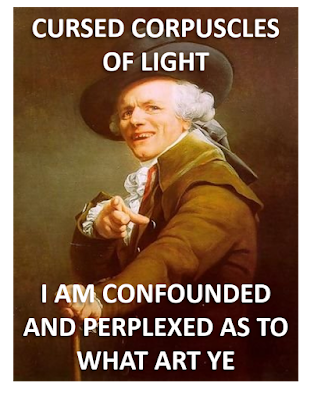Probably everybody has once or twice in their lifetime heard the word "photon" together with the phrase "oh, a photon is just a particle of light," or something along those lines. That's all well and good, but what does "particle of light" actually mean? Can you touch it? How big is it? What does it look like? What can you do with it? And who cares?
If someone talks about particles, you would expect them to mean that this thing is something solid, like a ping pong ball. You would also expect it to have some other properties that particles usually have, like it says on the wikipedia page about
particles: "
In the
physical sciences, a particle (or corpuscule in older texts) is a small
localized object to which can be ascribed several physical or chemical
properties such as volume or mass." Let's also take a look at what wikipedia says about
photons: "
A photon is
a type of elementary particle, the quantum of the electromagnetic field ... The
photon has zero rest mass and always moves at the speed of light within a
vacuum ... The quanta in a light wave cannot be spatially localized."
Mkay, so those two definitions seem less than compatible with each other. If this is so difficult, then why do we even need a particle of light? It all started from a grand disaster, now known as the
ultraviolet catastrophe. According to the classical theory - where light is taken strictly as a continuous electromagnetic wave - every single object with a non-zero temperature emits an
infinite amount of ultraviolet radiation. Now that does sound quite troublesome, since getting too much ultraviolet is
bad for you and all, not to mention that classical physics doesn't really like infinities.
The solution to this dire situation came from Max Planck, who reformulated the theory to what we now call
black-body radiation. He assumed that electromagnetic radiation can only be emitted or absorbed in discrete packages of energy, which is dictated by the wavelength of light. This was a strange assumption at the time, but it was accepted because it fit the observations. Later, Albert Einstein came along and proposed that these packages of light (lichtquant as Einstein called them), were not only mathematical constructions, but that light could only exist as discrete energy packages. After Arthur Compton called Einsteins lichtquant photons, the word was adopted widely.
Photons are important, not only in black-body radiation, but because they also explain the photoelectric effect and Compton scattering. Photons are also necessary in quantum mechanics and their statistics reflect the nature of a light source (I will talk about these things in some other posts). Then light is made up of particles, right? Well no, not in the way that most people think. As physics students know, if we have two overlapping waves, they
interfere. That is purely a wave phenomenon.
The above set of pictures depicts interference from a
double-slit experiment, where each dot is a recording left by a single photon. As the amount of photons increase, we see the familiar interference pattern emerge. These types of experiments are usually taken as demonstrations of the photons
wave-particle duality. Now a question: are those dots images of photons? The answer is no. Those dots are just the pixels that interacted with the photon, and absorbed all of its energy. The photon itself is spread out over space - like a wave - which then interacts with a single electron, collapses, and forfeits it's energy. Recent research has actually shown that it's possible to shape photons, meaning that they obey the Maxwell's equations and the wave equation. And these so called structured photons can have interesting properties, such as apparently
slowing down or
speeding up in certain cases.
What's going on? First there are no photons and light is a wave. Then all of a sudden, light is no longer a wave but made up of photons and now the photons are waves?!? Let's back up a bit, and look at how we define the photon. No one ever said that a photon is a particle in the same sense as an electron is a particle. All that was said was that a photon is a
package of energy, and nothing else. If you take an electromagnetic wave and start reducing it's energy, at what point does it stop being a wave? There is no such threshold, and the photon just depicts the lowest amount of energy at which the electromagnetic field is capable of self-sustained oscillation. The fact that the photon cannot be divided does not tell you anything about whether it is a wave or a particle, it just tells you about it's ability to interact with matter.
The reason we call photons particles is probably a historical one, because the word
quantum has sometimes been used in this meaning (electron was called the quantum of electricity), and the early theories of light also imagined
light to be a stream of particles. But according to recent evidence, the photon is an electromagnetic wave, although not a classical one!



Comments
Post a Comment